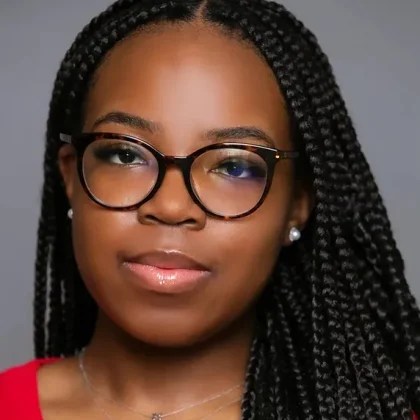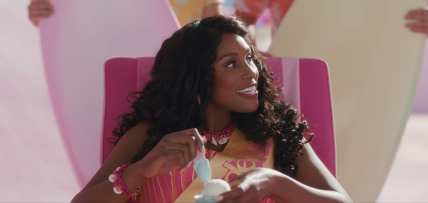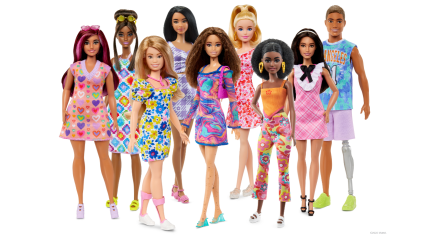Are Black women finally ready for their Barbie era?
Barbie-mania is taking over Hollywood and the fashion industry alike. But is there really a “Barbie World” for Black women?
Over the past few years, we’ve watched the world transition from boldly declaring its “hot girl summer” to peacefully claiming its “soft girl era.” Now, Issa Rae’s star turn in the upcoming “Barbie” live-action film has us wondering: Is 2023 destined to be a Black Barbie summer?

Leading up to the highly anticipated blockbuster’s release on July 21, the “Barbie” marketing teams have been working overtime. Having reportedly secured over 100 brand partnerships, from the virtual aisles of Amazon to in-person installations and collections at Gap, Neiman Marcus, Bloomingdale’s and more, Barbie has expanded well beyond the toy aisle as Mattel reminds everyone that it is a “Barbie World.” But just how inclusive and attainable is this fantasy world?
The appeal
Since its launch in 1959, Barbie has had an indelible impact on society. Rae accredits her childhood Christie doll – a Barbie sidekick and one of Mattel’s first Black dolls – for inspiring her role in the movie. In addition to influencing beauty standards (for better or worse), Barbie’s impact has repeatedly revealed itself in pop culture — which for Black women, has manifested most recently through artists like Nicki Minaj. Since the start of her career, Minaj’s brand has been heavily inspired by Barbie and Barbiecore. Dubbing herself the “Harajuku Barbie,” Minaj became known for her clever raps and vibrant pink wigs, while the rapper’s loyal fanbase became known as the “Barbz,” a shortened form of “Barbiez.”
“It’s definitely a movement at this point,” Minaj told MTV in 2010, explaining the origin of her fanbase’s moniker. “People really identify with me through that, and I definitely don’t think that when we say ‘Barbie,’ we’re thinking of the plastic little doll with the blond hair anymore. It’s really how we’ve come to define ourselves.”
Trend vs. trope
In Barbie’s dream world, she can rest, travel whenever she wants, wear whatever she wants, and ultimately do whatever she wants without judgment. Unfortunately, just as Barbie seemingly discovers in the film, life outside of “Barbie World” is not as fun and carefree. As Rae herself concedes, this is especially true for Black women.
“The strong Black woman trope hasn’t really helped any of us because it’s become an expectation,” Rae, Ebony’s July cover star, told the magazine. “Even when you express vulnerability, people are like, ‘Nah, you’re strong. You got it; you’re gonna get through this.’ Well, what if I can’t? Is it okay if I don’t make it through this?”
As many of us have experienced, historically, Black women have not been offered the luxury of rest or self-care. Constantly characterized as strong and resilient, many Black women have been subconsciously trained to minimize their feelings while working just as hard (and often harder) to get half as far as their white counterparts.
However, Black women have recently been encouraged to reclaim the power of their vulnerability via the “soft-life” trend. Celebrating a more relaxed, gentle and self-care-oriented lifestyle, the trend, started by Nigerian influencers, emphasizes prioritizing mental and emotional well-being, self-love, and creating spaces for rest and rejuvenation.
Pretty in pink?
Well before Warner Bros announced the film and its plethora of fashion collaborations, the fashion world tapped into “Barbiecore.” As society shifted away from the muted, serene tones of “millennial pink,” vibrant hues of hot pink and fuchsia reemerged into the mainstream, most memorably courtesy of Valentino’s Fall/Winter 2022-2023 collection.
In the fashion world, the soft-life trend has seamlessly intertwined with the rise of hot pink, creating a vibrant alliance that paints the world with a fierce and unapologetic hue of self-expression. From red carpets to runways, hot pink became one of the trending colors of 2022, with no sign of letting up for summer 2023.
As expected, the trend was also spotted on the Los Angeles “Barbie” premiere’s pink carpet as stars rocked various hues of hot pink — Barbie’s signature color. Despite her self-professed disdain for the color, Rae, who portrays President Barbie in the film, also tapped into the trend, wearing a custom hot pink Marc Bouwer gown styled by Wouri Vice. With a classic high ponytail courtesy of Felicia Leatherwood and “Barbie Doll Face” makeup by Joanna Simkin, Rae looked the part of a life-sized Barbie.
Exclusivity to inclusivity
Arguably, melanated complexions make Barbie pink pop the best, but Black beauty has not always been aspirational or even included in the fantasy Barbie world. At its inception, Barbie was an exaggerated model of a skinny, blond white woman who had it all. Though the doll’s hair color may have occasionally varied, for decades, the classic Barbie epitomized a beauty standard most women, especially Black women, could not relate to or live up to.
In the last 55 years, the brand has increasingly diversified the Barbie world, incorporating a variety of careers, complexions, body types and disabilities into its catalog. Currently representing over 35 different skin tones, 97 hairstyles, and nine body types, the brand has also worked to showcase diverse life experiences.
Accessible or aspirational?
Unlike the brand’s slogan, “You can be anything,” outside of Barbie land, we all know you can’t always afford everything. As lovely as the soft life/Barbie era sounds, it is a life of luxury, where Barbie’s world seems filled with more bliss than bills — but “life in plastic” is expensive!
Case in point: in addition to an inordinate amount of Barbie-pink merchandise in promotion of the film, the brand collaborated with Airbnb to create a real-life version of Barbie’s Malibu Dream House. The pink oceanfront mansion features several amenities, including an outdoor disco dance floor and a Barbie-inspired interior, coincidentally designed by a Black woman, Victoria Adesanmi.
But while fans can book an overnight Barbie experience through Airbnb, research shows one would have to earn at least $2 million annually to afford to live in Barbie’s nearly $10 million dream house. With Black women typically making an average of $36,303 per year compared to the $57,005 white men average annually in the United States, Barbie’s dreamhouse will remain a dream for most — at least until the racial and gender wage gap closes.
Now what?
With any trend, it’s easy to fall into the high-pressure whirlpool of conformity, especially in the age of social media. As more and more lifestyle influencers showcase their version of Barbie’s dream house and soft life via high-rise apartments with suspiciously similar neutral color palettes, it’s normal to feel like you have to keep up with the status quo.
However, just as Barbie, played by Margot Robbie, tries to escape the monotony of life in Barbie World, Black women continue to do the same in the real world. Here, we can borrow from one of Mattel’s most powerful initiatives with Barbie, The Dream Gap Project. According to the brand, research shows that as early as 5 years old, girls start to develop self-limiting beliefs that impact their self-esteem and confidence to pursue their dreams. This phenomenon, known as the Dream Gap, inspired the brand to launch a global initiative providing young girls with the resources and support to believe in themselves and continue to dream big.
While the gap has been proven to especially affect young Black girls, adult Black women can also benefit from its reminder. As Barbie-mania continues to paint the world pink, allow its nostalgia to reignite the wonder of childhood. Whether you call it your Barbie era or your soft-life era, the opportunity in this trend might be for Black women to dream bigger!

Haniyah Philogene is a multimedia storyteller and Lifestyle reporter covering all things culture. With a passion for digital media, she goes above and beyond to find new ways to tell and share stories.
TheGrio is FREE on your TV via Apple TV, Amazon Fire, Roku, and Android TV. TheGrio’s Black Podcast Network is free too. Download theGrio mobile apps today! Listen to ‘Writing Black‘ with Maiysha Kai.


